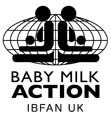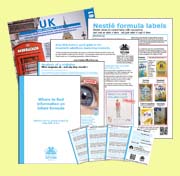Philippines Typhoon - Protecting infant health through breastfeeding.
To understand the complexity of the situation and the pressures on those trying to protect infant health - read this first hand account by VELVET C. ESCARIO-ROXAS
You can see a picture of Velvet campaigning about BPA on the IBFAN website HERE
CLICK here for an INQUIRER NEWS STORY
November 21st 2013
Two islands that were hit by Haiyan are the islands were my family reside. We are now grieving for our 2 dead relatives. The 3 relatives who were missing for a few days have now been found. This typhoon hit us so bad, unbelievably beyond proportion. Here are a few updates and news from the Philippines post-Yolanda (Haiyan) typhoon at one of our evacuation centers.
Four Arugaan moms visited Villamor Airbase (where they fly in survivors from Leyte/Samar areas) the Nanay Bayanihan Tent (Mother-Baby friendly space). It's a space meant for babies 0-2 years old. The moms-babies can rest here and breastfeeding counseling is given.
Villamor is quite far from our place, 1 hour on a happy day and 2 hours on traffic hours. Fortunately, we had a generous mom who gave us a free ride to and from our homes to Villamor. She has pledged to do this regularly as long as Arugaan moms would be willing to do breastfeeding peer counseling and mother-to-mother support to the survivors of Haiyan.
When we arrived, we were briefed with the things we needed to do. We just needed to wait for the planes to arrive. However, for the hours that we were there we did more 'housekeeping' and 'house cleaning' than counseling. First, we had to clean and arrange the things to give it more space. The current space can only hold about 4 moms but with a much bigger space, now it can hold about 6-7 moms. We had to ensure that the structure and space is clean, free from eyesore and the moms can feel 'at home'.
Then we had to sort out the relief packages that were supposed to be given to the moms. These were donations and inside there were: baby wipes, diapers, bottles, Nestogen, biscuits, Cerelac etc. Any 'food' that was inside the package we had to 'safekeep'. So now, we have boxes and boxes of bottles, bottle cleaners/brushes, formula milk, Cerelac, biscuits etc. They are put in separate boxes inside the tent. I wanted them disposed of because it's eating too much space on our very little space. One neonatologist already talked with DOH (Department of Health) that they need to get these boxes from us. When DOH visited us yesterday, they said that they cannot 'touch' them. It should be given to Department of Social Welfare and Development (DSWD). We are hurtfully hesitant to give these boxes to DSWD because they have been asking for formula, even though they know this will put babies at risk of death through sepsis, diarrhea etc. Indeed we are at our wits ends. We have too many things on our hands, that we are now on a big bump in the Bayanihan Tent. Any suggestions? We obviously cannot bring them to our homes.
I do have a confession to make and giving me goosebumps. I was bringing some stuff to my home to wash, clean and segregate. When I got home and checked the boxes, I had one garbage-bag-full of bottles and teats. Oh goodness! What will I do with these things? Ever since I have learned to cup feed my 11-year old when she was a baby, I never had to buy any bottles ever. And now I have them in my home.
Looking back a few days ago, during the first day of the Nanay Bayanihan Tent operation. A lot were giving these formula milk and bottles. The organizers were not accepting them and telling these people that it's against our Milk Code. They quarreled and shouted at our peer counselors and doctors. And when they turned their backs, they just handed out milk every time they saw moms and babies. At the tent, the counselors and doctors would sequester them again. It was a vicious cycle. So as a strategy, all baby donations now go to the Bayanihan Tent. But we also have an influx of all these unnecessary baby products.
These mothers do not need formula milk. Out of the 10 moms, only 1 is mixed/formula feeding. The tent is run by private individuals who want to protect, promote and support the mothers and babies during emergencies. We have pediatricians, neonatologists, peer counselors and volunteers. Different organizations have given their time and effort to also help including Kalusugan ng Mag-ina, Arugaan, Latch, Breastfeeding Pinays and Kaya. This is the first of its kind in the Philippines. We hope and pray that this will be successful and that this will become a model of care for moms and babies in our country. We do need lots of improvements in our tent. For one, we need experienced breastfeeding counselors who can bring a baby back to the breast when they are formula feeding. An example is a mom-baby 2 months and never breastfed. A volunteer said "oh this mom is formula feeding, she doesn't need breastmilk." We have 2 types of volunteers. Those from the online sign-up sheet coming from Breastfeeding Pinays. Others who have signed up at the Villamor airbase. I have made recommendations that volunteers should not be allowed in the tent. As a strategy, only those with socks can get inside the tent. Those from Breastfeeding Pinays group are briefed online. We are thinking of not letting the Villamor volunteers be involved since a lot of them know nothing about breastfeeding. But these are also the volunteers who go around the camp and when the plane lands to fetch the moms-babies and bring them to the tents. How do we make the experienced breastfeeding peer counselors more available when we only do this as voluntary basis? That is our biggest problem in the operation of the evacuation tent. We are still on Day 7 of the Nanay Bayanihan Tent operation. And we will be moving this noontime at Camp Aguinaldo. Another logistical nightmare for everyone in the evacuation center. We still need to strategize on how we can follow-through on the moms who are formula feeding. There are many gaps and we need to close the loop. So much work to be done... Oh! Mead Johnson has asked clearance from the IAC (Inter-Agency Committee) to donate formula milk. Other milk companies have donated money. But MJ is just soooo thick-skinned! Attached are photos of the boxes of formula milk and donations. I hope this gets through, I've sent 2 emails with many pictures but I'm being rejected because the attachment is too large. Thank you.
Reporting from the Philippines... Velvet
VELVET C. ESCARIO-ROXAS "Helping Mothers Breastfeed"
+63-915-7741614 velvethere@yahoo.com
INQUIRER NEWS: JUNJIE MENDOZA/CEBU DAILY NEWS DAVAO CITY Groups urge breast milk for babies in storm shelters Tuesday, November 19th, 2013
http://newsinfo.inquirer.net/530599/groups-urge-breast-milk-for-babies-in-storm-shelters
A GIRL sips juice after she and her family fled Tacloban City and arrived in Cebu City. Groups are protesting the distribution of infant milk formula for babies in shelters, saying breast milk is best even during times of disaster. Groups advocating breast-feeding are raising a howl over reports that powdered milk products have been included in relief being distributed to survivors of Supertyphoon “Yolanda.”
Dr. Donna Capili, of the group Kalusugan ng Mag-Ina Inc. (KMI), said breast milk should not be substituted by infant milk formula, or powdered milk being produced by multinational firms. KMI is one of several groups behind “Nanay Bayanihan,” a campaign to provide breast milk for babies that survived Yolanda. Nanay Bayanihan has a tent in Villamor Air Base, where hundreds of survivors of Yolanda from Leyte, Samar and other areas in the Visayas, are being unloaded by C-130 military planes.
Capili said babies, especially those who survived Yolanda, need protection from the ill effects of infant milk formula. Capili cited the case of a woman who had been used to breast-feeding her baby but unknowingly fed her baby infant milk formula upon arrival at the air base because she lacked awareness about the difference between powdered and breast milk.
“She thought it was what her baby needed,” said Capili. “I told her that even if she was hungry and tired, the milk volume and quality (from her breasts) are still the same,” Capili added. The powdered milk apparently was donated. Capili said this should not be the case.
The inclusion of powdered milk in relief, said Capili, left the impression that it is a substitute for breast milk. Groups behind Nanay Bayanihan are applying the strategy Infant Feeding in Emergencies (IFE) recommended by the World Health Organization in crisis situations, such as those brought by the aftermath of Yolanda. Aside from its potential health risks to babies, the promotion of powdered milk by including this in relief also violates Executive Order No. 51, or the Philippine Milk Code, according to Capili. Haide Acuna, another breast-feeding campaigner who had visited evacuation centers in Cebu, said the condition of babies who had been brought to the shelters offered a clear image of the ill effects of powdered milk.
“All infants with diarrhea, near death with dehydration and sent to hospitals straight from C-130 (planes) are all bottle- and formula-fed,” Acuna said on her Facebook post. “All babies who are breastfed are well and not even sick despite
getting soaked cold last Friday (when Yolanda hit),” she added.
Danika Christin Magoncia, who survived Yolanda in Tacloban, said on her Facebook account that she “can never underestimate the power of breastfeeding.”
“With our water and food supply running low, I just breast-fed and breastfed my son,” Magoncia said. “If our child had been dependent on milk formula, I would have taken part in looting, too,” she quoted her husband as saying.
“When we went out to forage for food, I saw people looting formula milk for their babies,” she added. Capili said even if the baby were bottle-fed before Yolanda, the baby could be breast-fed anytime.
“If the baby is on formula and less than 6 months of age, the period during which he or she should be exclusively breast-feeding, the main option is for the mother to relactate,” Capili said. “This process does not take overnight,” she said. But Capili said if the child is over six months old and is still being bottle-fed, “the focus should be on good complementary feeding.” “Older babies, especially those over a year of age, should really be eating and not so dependent on milk for nutrition,” she said.
For Acuna, food delivery is not a simple choice between bottled or breast milk. “It is actually a choice between life and death when calamity strikes,” she said. Nico Alconaba, Inquirer Mindanao
- Login to post comments






